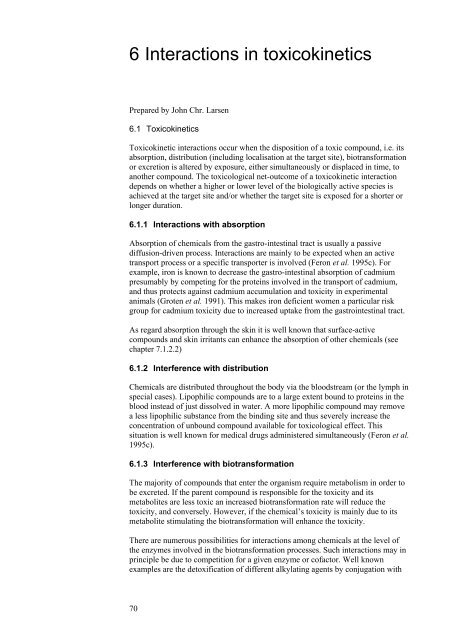Combined Actions and Interactions of Chemicals in Mixtures
Combined Actions and Interactions of Chemicals in Mixtures
Combined Actions and Interactions of Chemicals in Mixtures
Create successful ePaper yourself
Turn your PDF publications into a flip-book with our unique Google optimized e-Paper software.
6 <strong>Interactions</strong> <strong>in</strong> toxicok<strong>in</strong>etics<br />
Prepared by John Chr. Larsen<br />
6.1 Toxicok<strong>in</strong>etics<br />
Toxicok<strong>in</strong>etic <strong>in</strong>teractions occur when the disposition <strong>of</strong> a toxic compound, i.e. its<br />
absorption, distribution (<strong>in</strong>clud<strong>in</strong>g localisation at the target site), biotransformation<br />
or excretion is altered by exposure, either simultaneously or displaced <strong>in</strong> time, to<br />
another compound. The toxicological net-outcome <strong>of</strong> a toxicok<strong>in</strong>etic <strong>in</strong>teraction<br />
depends on whether a higher or lower level <strong>of</strong> the biologically active species is<br />
achieved at the target site <strong>and</strong>/or whether the target site is exposed for a shorter or<br />
longer duration.<br />
6.1.1 <strong>Interactions</strong> with absorption<br />
Absorption <strong>of</strong> chemicals from the gastro-<strong>in</strong>test<strong>in</strong>al tract is usually a passive<br />
diffusion-driven process. <strong>Interactions</strong> are ma<strong>in</strong>ly to be expected when an active<br />
transport process or a specific transporter is <strong>in</strong>volved (Feron et al. 1995c). For<br />
example, iron is known to decrease the gastro-<strong>in</strong>test<strong>in</strong>al absorption <strong>of</strong> cadmium<br />
presumably by compet<strong>in</strong>g for the prote<strong>in</strong>s <strong>in</strong>volved <strong>in</strong> the transport <strong>of</strong> cadmium,<br />
<strong>and</strong> thus protects aga<strong>in</strong>st cadmium accumulation <strong>and</strong> toxicity <strong>in</strong> experimental<br />
animals (Groten et al. 1991). This makes iron deficient women a particular risk<br />
group for cadmium toxicity due to <strong>in</strong>creased uptake from the gastro<strong>in</strong>test<strong>in</strong>al tract.<br />
As regard absorption through the sk<strong>in</strong> it is well known that surface-active<br />
compounds <strong>and</strong> sk<strong>in</strong> irritants can enhance the absorption <strong>of</strong> other chemicals (see<br />
chapter 7.1.2.2)<br />
6.1.2 Interference with distribution<br />
<strong>Chemicals</strong> are distributed throughout the body via the bloodstream (or the lymph <strong>in</strong><br />
special cases). Lipophilic compounds are to a large extent bound to prote<strong>in</strong>s <strong>in</strong> the<br />
blood <strong>in</strong>stead <strong>of</strong> just dissolved <strong>in</strong> water. A more lipophilic compound may remove<br />
a less lipophilic substance from the b<strong>in</strong>d<strong>in</strong>g site <strong>and</strong> thus severely <strong>in</strong>crease the<br />
concentration <strong>of</strong> unbound compound available for toxicological effect. This<br />
situation is well known for medical drugs adm<strong>in</strong>istered simultaneously (Feron et al.<br />
1995c).<br />
6.1.3 Interference with biotransformation<br />
The majority <strong>of</strong> compounds that enter the organism require metabolism <strong>in</strong> order to<br />
be excreted. If the parent compound is responsible for the toxicity <strong>and</strong> its<br />
metabolites are less toxic an <strong>in</strong>creased biotransformation rate will reduce the<br />
toxicity, <strong>and</strong> conversely. However, if the chemical’s toxicity is ma<strong>in</strong>ly due to its<br />
metabolite stimulat<strong>in</strong>g the biotransformation will enhance the toxicity.<br />
There are numerous possibilities for <strong>in</strong>teractions among chemicals at the level <strong>of</strong><br />
the enzymes <strong>in</strong>volved <strong>in</strong> the biotransformation processes. Such <strong>in</strong>teractions may <strong>in</strong><br />
pr<strong>in</strong>ciple be due to competition for a given enzyme or c<strong>of</strong>actor. Well known<br />
examples are the detoxification <strong>of</strong> different alkylat<strong>in</strong>g agents by conjugation with<br />
70

















